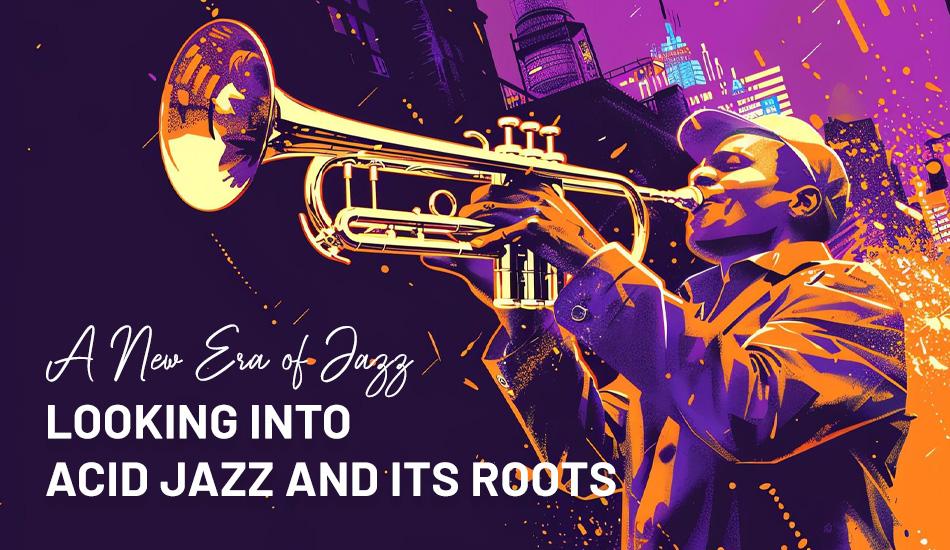Jazz music has always been changing; with time, it has developed many subgenres that have enthralled listeners worldwide. Of the different trends in jazz culture, one of the most fascinating is the appearance of acid jazz as a trademark of a new jazz era in its interaction with modern tendencies. In this learning process, let us look at the background of acid jazz, the elements of the music, as well as the continuous impact of acid jazz on modern society.
Acid jazz is one of the important stages in the development of jazz as a kind of music that combines numerous traditions that emerged in the late twentieth century. This new jazz era was intended to blend funk, soul, hip-hop, and electronic jazz to compile a single distinct style that is of notable significance and comprehensible. Thus, the most important effect of acid jazz is that it not only preserved and popularized traditional jazz and stimulated musicians to create new compositions, but also presented the genre to new generations and people with different interests. The electronic elements, danceable commands, and the very conspicuous fact that most of the traits were improvised offered it a unique appeal it got from other schools of music. They gave it an influence that impacts even the music makers of today.
What is Acid Jazz?
Acid jazz is a genre that emerged in the 1980s and gained prominence in the 1990s. It uniquely blends jazz, funk, soul, hip-hop, and electronic music elements. Characterized by live instrumentation such as horns, keyboards, and percussion, acid jazz also incorporates electronic sounds and techniques. Improvisation and experimentation are key aspects of the acid jazz ethos, along with catchy melodies and danceable rhythms. This genre has significantly impacted broader music culture, influencing other genres like neo-soul and trip-hop, and remains a vibrant and exciting genre with a dedicated fan base.
History of Acid Jazz
French-English DJ Gilles Peterson coined the term “acid jazz” in the mid-1980s to distinguish it from the popular acid house music of that era. In 1988, Peterson and Eddie Piller founded Acid Jazz Records to promote dance artists who utilized rare groove sampling, exploring obscure mid-century jazz records. The release of the Wired album was pivotal in laying the groundwork for what would become acid jazz. This genre emerged as a response to the growing club culture, combining jazz’s improvisational spirit with the groove-oriented sounds of funk and electronic music.
What Are the Highlights of Acid Jazz?
For this reason, acid jazz has seen several major developments in its evolution which defines its sound. One of the keys to the genre’s development was jazz fusion, a music style characterized by free-form improvisation, with funky beat rhythms and electronic textures. This combination made for a fresh sound that was anchored in the past but moving into the future at the same time. Thus, the principal features of the acid jazz style include stylish groovy beats and bass lines, elaborate melodic ideas, and a successful combination of live and electronic instruments. It can be said that the genre’s flexibility and constant alterations while preserving somewhat of its essence, have helped ensure longevity.
Is It a Popular Jazz Style?
During the 1990s, acid jazz enjoyed considerable popularity, particularly in the UK. It was a prominent subgenre of jazz-funk and fusion, attracting a dedicated following. However, it did not gain popularity like the other jazz subgenres, like smooth jazz or even standard jazz. Although in recent years not as much attention is paid to acid jazz as in the early 2000s, it has and still has its fans, and elements of it can be heard in post-modern music. Presently, acid jazz is considered a part of jazz history and is awarded much attention for its impact on the further development of jazz.
The Best Acid Jazz Artists and Albums Ever
Dangerous Liaisons by Sylvia Brooks
Acid Jazz is enriched with the singing style of Sylvia Brooks, a prominent jazz artist. “Dangerous Liaisons” probably says it all about her consistency in furthering her jazz skills, which portray jazz’s emotive foundation and freedom of creativity.
Guru, Jazzmatazz, Vol. 1
The United Future Organization group, formed in Japan in 1990, produced the album with the same name in 1993 and can be considered an acid jazz album. Songs that perfectly illustrate Transitions: In the track titled Poetry and All That Jazz and Vinyl Junkie the competency of the artists in integrating jazz funk and future sound is conspicuous.
United Future Organisation, United Future Organization
The United Future Organization, originating from Japan in 1990, created their album of the eponymous name in 1993, which can be rightly dubbed an acid jazz record. Songs that perfectly illustrate Transitions: Poetry and All That Jazz’ and Vinyl Junkie’ demonstrate the artists’ competence in fusing jazz, funk and the future sound.
Home Rulez, Mojito
This Korean group combines acid jazz with electronica and R&B in the cheerful tune of Mojito in 2007. Two that stand out most are “Do It” and “My fantastic black hat.”
Justice System, Rooftop Soundcheck
The Justice System released its album Rooftop Soundcheck in 1994. It features hip-hop jazz. ‘Trouble On My Mind’ highlights saxophone, as does ‘Summer In The City, ’ which has funky guitar and brass.
Topaz, The Zone
Formed in 1997, Topaz has been active in the acid jazz scene for quite some time. Their album The Zone has some samples, such as “Minha Mente” and “4th & D,” proving the band’s growth.
Jamiroquai, Blow Your Mind – Emergency on Planet Earth
The band released its first album, Emergency on Planet Earth, in 1993, which was a major hit. It was full of Jazz and Funk, and most of all, it showcased the unique style of their frontman, Jay Kay.
Spirit of Voyage, Mondo Grosso
Mondo Grosso, the Japanese producer Osawa Shinichi, is one of the prominent acid jazz artists, combining house, jazz, and blues to compose ageless backdrops.
Brand New Heavies
First performing acid jazz in 1985, Brand New Heavies are distinguished for their live performances and ability to merge jazz, funk, and soul elements.
Brooklyn Funk Essentials
Brooklyn Funk Essentials, which appeared in the 1990s, is an example of a musical group combining funk, jazz, hip-hop, and afrobeat elements in their work.
St. Germain
French musician Ludovic Navarre, who leads St. Germain, has been influencing acid jazz since the early 90’s and is considered a Jazz/House/Blues artist.
Conclusion
Acid jazz is a new era that shows that jazz can grow and share roots with many different styles. Acid jazz began in the early 1980s and became very popular in the early 1990s, although it is still remembered and has influenced the music industry. Jazz-funk/soul/hip hop/techno/electronic music is a blend that has made it stand out from other bands due to its creativity in its blend of various elements of music. Learning more about the top acid jazz artists and the albums they produced enables the audience to understand the potential of this unique style of the jazz genre. Regardless of how familiar one may be with acid jazz, there is always some freshness in the genre.
Acid jazz stands out as a testament to the genre’s enduring creativity and adaptability. As we celebrate the new era of jazz, the legacy of acid jazz will continue to influence and inspire future generations of musicians and listeners alike.




